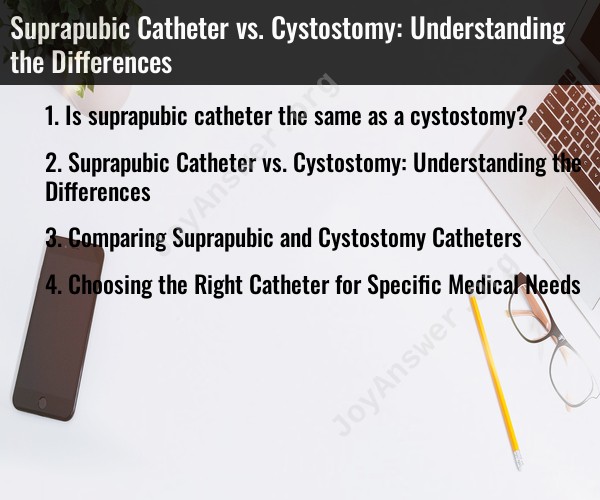Is suprapubic catheter the same as a cystostomy?
A suprapubic catheter and a cystostomy are related but not exactly the same. Both involve the insertion of a catheter into the bladder through the abdominal wall, but there are differences in terms of the procedure, location, and purpose.
Suprapubic Catheter:
- A suprapubic catheter is a type of urinary catheter that is inserted into the bladder through the abdominal wall, just above the pubic bone.
- It is often used for temporary or long-term bladder drainage when a patient cannot use a urethral catheter (indwelling catheter) due to a blockage, injury, or other medical reasons.
- The catheter is typically inserted in a surgical procedure, which may be performed in a hospital or clinical setting.
- It is considered less prone to urinary tract infections compared to urethral catheters.
- Suprapubic catheters are often used in situations where long-term bladder drainage is needed, such as for patients with spinal cord injuries, urinary retention, or certain medical conditions.
Cystostomy:
- A cystostomy, on the other hand, is a surgical procedure that creates a permanent or temporary opening in the bladder through the abdominal wall.
- The primary purpose of a cystostomy is to allow direct access to the bladder for various medical procedures or interventions. It is not specifically used for continuous urinary drainage but rather for specific medical purposes.
- A cystostomy can be created for diagnostic procedures, to remove bladder stones, or to perform certain types of surgery or treatments.
- While a cystostomy may involve the placement of a catheter through the abdominal wall, it's not always used for continuous drainage of urine. The catheter may be inserted temporarily for a specific procedure and then removed.
In summary, a suprapubic catheter is a type of urinary catheter used for bladder drainage, while a cystostomy is a surgical procedure that creates an opening in the bladder for various medical interventions. The key distinction is in the purpose and usage, with the suprapubic catheter primarily serving as a means of urinary drainage and the cystostomy primarily serving as a means of access to the bladder for medical procedures.
Suprapubic Catheter vs. Cystostomy: Understanding the Differences
Suprapubic catheter (SPC) and cystostomy are both surgical procedures that create an opening into the bladder to drain urine. However, there are some key differences between the two procedures.
Suprapubic catheter is a less invasive procedure than cystostomy. It is performed under local anesthesia, and a small incision is made above the pubic bone. A catheter is then inserted through the incision and into the bladder. The catheter is secured to the skin with sutures or a device called a trocar.
Cystostomy is a more invasive procedure than suprapubic catheter. It is usually performed under general anesthesia, and a larger incision is made in the abdomen. The bladder is then exposed, and a catheter is inserted into the bladder through the incision. The catheter is secured to the skin with sutures or a trocar.
Comparing Suprapubic and Cystostomy Catheters
Here is a table comparing suprapubic and cystostomy catheters:
| Characteristic | Suprapubic catheter | Cystostomy |
|---|---|---|
| Incision size | Small | Large |
| Anesthesia | Local | General |
| Procedure time | Shorter | Longer |
| Risk of complications | Lower | Higher |
| Recovery time | Faster | Slower |
Choosing the Right Catheter for Specific Medical Needs
The best type of catheter for a particular patient will depend on their individual medical needs. For example, patients who are unable to tolerate general anesthesia or who have a high risk of complications from surgery may be better candidates for a suprapubic catheter. Patients who need long-term bladder drainage may be better candidates for a cystostomy.
It is important to talk to your doctor about the best type of catheter for you. They can help you weigh the risks and benefits of each procedure and choose the option that is best for your individual needs.
Here are some specific medical needs for which either a suprapubic catheter or cystostomy may be recommended:
- Neurogenic bladder: A neurogenic bladder is a bladder that does not function properly due to nerve damage. People with neurogenic bladders may need a catheter to drain their bladders completely.
- Bladder obstruction: Bladder obstruction is a blockage in the bladder that prevents urine from flowing freely. People with bladder obstruction may need a catheter to drain their bladders until the obstruction is removed.
- Urinary incontinence: Urinary incontinence is the loss of bladder control. People with urinary incontinence may need a catheter to collect their urine if they are unable to control their bladder.
- Postoperative bladder drainage: After some surgeries, patients may need a catheter to drain their bladders for a short period of time.
If you have any questions or concerns about suprapubic catheters or cystostomy, please talk to your doctor.













